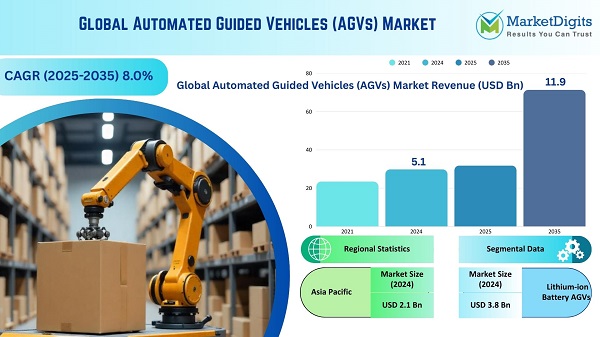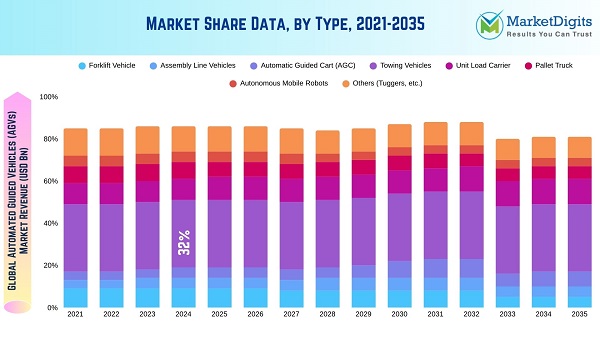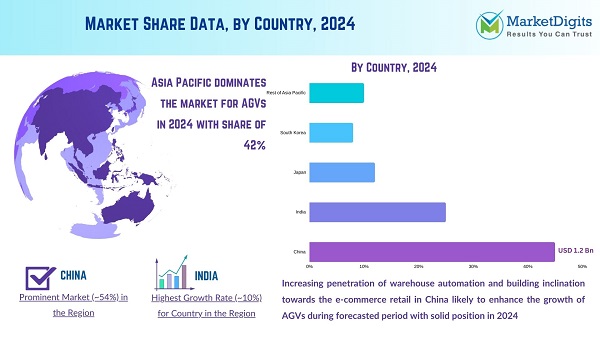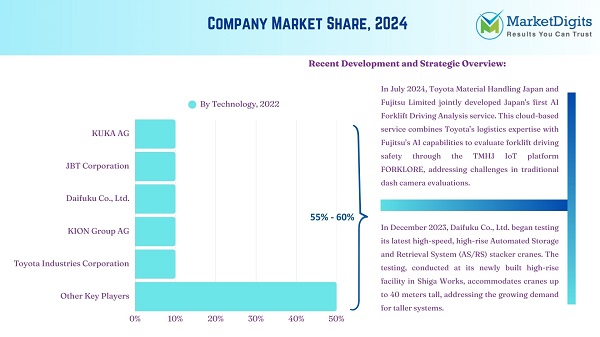- Home
- Automotive & Transportation
-
Automated Guided Vehicles Market

Automated Guided Vehicles (AGVs) Market Size, Share, Growth Opportunity Analysis Report by Type (Forklift Vehicle, Assembly Line Vehicles, Automatic Guided Cart (AGC), Towing Vehicles, Unit Load Carrier, Pallet Truck, Autonomous Mobile Robots, and Others (Tuggers, etc.)), Technology, Battery Type, Battery Capacity, Load Capacity, End-use Industry, and Geography (North America, Europe, Asia Pacific, Middle East, Africa, and South America) - Global Industry Data, Trends - Forecast 2025‒2035
Industry : Automotive & Transportation | Pages : 180 Pages | Published On : Apr 2025
Responding the increasing industry interest in flexible and affordable automation, Scott Technology announced its new Automated Guided Vehicle (AGV), NexBot, at ProMat 2025. Modular and scalable in design, NexBot allows for quick deployment and affordable operations. This focuses the long-standing issues of operation namely, long lead times and system integration complexity with a streamlined solution that is consistent with evolving logistical and manufacturing needs.
NexBot resolves manufacturing obstacles through its modular construction that proceeds installations faster and reduces operational delays while monitoring operations continuously 24/7 hours per day.
— Mike Christman, CEO, Scott Technology
Recent advancements in the AGV sector now prioritize three main factors including operational speed and continuous plant operation combined with rapid return on investment.
Automated Guided Vehicles (AGVs) Market Size, Share, and Growth
The rapid growth for AGVs is attributed to the expansion by key players in the new market and geography. Industry 4.0 and the greater adoption of smart factories have seen AGVs more in demand than ever before, as companies seek smarter and more efficient means to automate their business.

The AGVs market growth is increasing rapidly due to the advancement and adoption of new technology, and because of this the demand of AGVs is also rapidly increasing in automation industry. With new technologies and research, the AGVs are advancing with new generation technologies interaction like AI (Artificial Intelligence), IoT & Machine Learning. The increase in e-commerce also the reason for warehouse automation, which increase the demand for AGVs.
Automated Guided Vehicles (AGVs) Market Dynamics and Trends
Driver: Advancements in Technology Leading to Enhanced Performance, efficiency, accuracy, Rapid growth of E-commerce
- The new technology is interacting with the AGVs and it will improve the ability to handle the situation in complex environmental with very less human interaction. AI (Artificial Intelligence) also transforming this industry on big level as the use of AI in AGVs expands the scope in more accuracy in operations, less fault, enhance efficiency, time utilizing, improves movement, reduce the cost of operation. "As labor shortages persist and costs rise, businesses must adopt automation to stay competitive in an evolving logistics and warehousing landscape,” says Mike Christman, CEO of Scott Technology.
- New research in robotics enhances the capability of AGVs by use in accessing higher loads and using in major sectors like automotive, steel manufacturing & construction. In this the material in AGVs are durable and the sensors are robust. LiDAR (Light Detection and Ranging) and vision-based navigation systems are used in advanced AGVs and the result they automatically map environments without any human interaction.
- As E-commerce is growing the smart warehouse is also advancing with the use of AGVs with less interaction of humans. E-commerce platforms are becoming the first choice for the retail purchase of the goods and as of 2024, more than 60% companies have adopted online distribution network. This growth in the e-commerce sector increases the use of AGVs in warehousing and logistics. The use of automation in this industry is increasing as the Automated Guided Vehicles is the top priority.
- Major online retail giants rely majorly on the AGVs for their warehousing operations. For instance, e-commerce players such as Alibaba and Amazon has achieved more than 80% automation in their warehouses and are heavily depend on the robotics systems such as Automated Guided Vehicles (AGVs).
Restraint: High Initial Cost of AGVs and Supply Chain and Integration Challenges
- The raw material used by Automated Guided Vehicle (AGV) market include structural steels, forged and processed steel bars, steel pipes, steel roads, electric motor, bearings, gear reducers and other electrochemical parts for manufacturing and design purpose. Steel is one of the major raw materials that is obtained from iron ore, and its price fluctuation is a big issue. Raw material vendor’s actions for fluctuating the higher prices to depending sectors, such as Automated Guided Vehicles (AGVs) manufactures, may inhibit the market growth. These uncertainties create challenges for Automated Guided Vehicles (AGVs) manufacturers in raw material purchasing.
- Adoption of Automated Guided Vehicles (AGVs) is hampered by complex and potentially disruptive integration into current operations, incompatibility with legacy systems, and the accurate communication among AGVs, sensors, and infrastructure.
Opportunity: Innovation and Customization Are Powering AGV Market Growth
- The Automated Guided Vehicles (AGVs) market is experiencing outstanding innovation created by technological advancement in artificial intelligence, robotics, machine learning and sensors. These technologies are making AGVs more autonomous and efficient across every sectors.
- The integration of AGVs with Warehouse Management Systems (WMS), IoT platforms, and new technologies like 5g and edge computing is enabling real time tracking of stock, predictive maintenance, and faster decision making. As more industries turn to automation, the global AGV market is seeing major growth, with companies seeking smarter, more affordable way to move materials efficiently.
- Corporations focus on supply chain flexibility and operational coordination, the demand for customized AGV solutions to meet the specific industry requirements is creating a major opportunity for manufacturers to look and expand their product portfolio.
Key Trend: Advanced Technologies Are Powering AGV Adoption across a Wide Range of Industries
- The period 2025-2035 will most probably witness major technology transformation driven by AI, IoT and 5G, also with growing adaption of environmental sustainability and smart manufacturing regulations, as businesses adapt greener alternatives, the trend towards growing freedom in AMRs will be most likely change AGVs design, leading to the hybrid solutions that mix the path guidance with dynamic AI-driven decision-making.
- The current trend in the Automated Guided Vehicles (AGVs) industry is the widespread adoption by big giants in e-commerce for improving operational effectiveness. For example, Indian e-commerce giant Flipkart has started using robot-driven sortation technology through Automated Guided Vehicles (AGVs) at its Bengaluru sortation center. It reflects the shifting focus in a way to increased automation to minimize logistics complexity, increase speed, and manage high load during the extra peak seasons.
Automated Guided Vehicles (AGVs) Market Analysis and Segmental Data
Towing Vehicles and IoT-Driven Automation to Lead AGV Market Growth by 2035
- The Automated Guided Vehicles (AGVs) market is undergoing a major transformation, and this is because the involvement of AI-powered decision making, digital integration, and advance intelligent logistics that can change according to the real time. Towing vehicles are the most common form of AGV, their big impact for capacity to transport heavy loads majorly over the distance, especially in logistics, aerospace and e-commerce where maximizing productivity and costs reducing is the top most priority.

- As warehouses continue to face the increasing pressure for their efficiency and problem with shortage of staffing, AGVs are speedily becoming a big factor of warehouse systems today. Reason is integrated IoT sensors, AGVs can smoothly integrate with Warehouse Management Systems (WMS) and ERP systems for enabling the teams to observe inventory in real-time, manage maintenance needs and for shipping orders quickly. Companies such as Toyota Material Handling Europe already are at the forefront of introducing high-density Automated Guided Vehicles (AGVs) and pallet shuttle systems designed to adaption of optimize storage capacity and better utilize manpower.
Asia pacific dominates the market for Automated Guided Vehicles (AGVs)
- The Asia-Pacific, with big manufacturing giants including China and India are at the face, is likely to experience the highest CAGR in the Automated Guided Vehicles (AGVs) industry, generated due to high industrialization, increasing e-commerce, increasing investments in high-end automation, and the increasing demand for effective warehouse and inventory management in industries like automotive, food, retail and beverages. For instance, In India Sona Comstar and TiHAN-IIT Hyderabad collaborate to develop innovative connected, autonomous, and electric technologies for AGVs, drones, and eVTOLs, promoting advancements in future mobility solutions through shared expertise in research and manufacturing.

- The European AGV market is growing, due to the regions smart automation sector, increase use of automation in manufacturing and logistics, and sustainability drive. Italy, Germany and France are the face of combine AGVs into smart factories and technically advance warehouse, with electric AGVs showing the energy-efficient and greener operations.
Automated Guided Vehicles (AGVs) Market Ecosystem
Key players operating in the AGVs Market are Daifuku, JBT, KION Group AG, Jungheinrich AG, Hyster-Yale Material Handling, SSI Schaefer, Dematic, Seegrid Corporation, Bastian Solutions, Murata Machinery, Swissloog, E&K Automation, Transbotics Corporation, AGILOX, Zebra Technologies Corporation, Clearpath Robotics, inVia Robotics Inc and others.
In addition to these manufactures, the AGV ecosystem also consists of battery manufacturers, providers of charging infrastructure, and technology companies which specialize in electric drivetrains and energy storage solutions. Collaboration among all these stakeholders is necessary to drive technology improvements in AGVs and open up the markets for them.

Recent Development and Strategic Overview:
- In April 2025, Photoneo has published the PhoXi control and Firmware Update 1.14, which introduces new and major upgrades in 3D vision accuracy. These will benefit pick and place robotic arms and enhance AGV navigation, enhancing precision and efficiency in automated system and AGV.
- Siemens Smart Infrastructure has announced the acquisition of Danfoss Fire Safety, a subsidiary of the Danfoss Group that specializes in fire suppression technology, as of October 2024. This move will amplify the Siemens portfolio for fire suppression, more especially towards high-pressure water mist technology, as well as green solutions for fire safety, says the company official.
Cloud Engineering Market Size, Share & Trends Analysis, By Deployment (Public, Private, Hybrid), By Service (IaaS, PaaS, SaaS), By Workload, By Enterprise Size By End-use, By Region, And Segment Forecasts
TOC
Table of Contents
1. Executive Summary
1.1. Global Automated Guided Vehicles (AGVs) Market Outlook
1.1.1. Automated Guided Vehicles (AGVs) Market Size (Volume – Mn Units and Value - USD Bn), and Forecasts, 2021-2035
1.2. Compounded Annual Growth Rate (CAGR) Analysis, 2025-2035
1.3. Supply-Demand Analysis
1.4. Market Dynamics, Analysis, and Facts
1.4.1. Growth Potential Factors
1.4.2. Market Risks and Challenges
1.4.3. Forecasted Opportunity Analysis
1.5. Competition Assessment
1.5.1. Company Market Share (CMS), 2024
1.5.2. Business Overview and Product Data, by Key Players
1.5.3. Strategic Overview and Recent Development, by Key Players
2. Premium Insights
2.1. Key Forecast Factors & Impact Analysis
2.2. Supplier Data
2.3. Technology Roadmap and Developments
2.4. Pricing Analysis, by Vehicle Type, by Region/ Zone
2.5. Trade Analysis (For AGVs and Components)
2.6. Component Share and Analysis for AGVs
2.7. Analysis and Recommendations
3. Market Overview
3.1. Market Dynamics
3.1.1. Drivers
3.1.2. Restraints
3.1.3. Opportunity
3.2. Key Trend Analysis
3.3. Regulatory Framework
3.3.1. Key Regulations, Norms, and Subsidies, by Key Countries
3.3.2. Tariffs and Standards
3.3.3. Impact Analysis of Regulations on the Market
3.4. Value Chain Analysis
3.4.1. Component/ System Suppliers
3.4.2. Automated Guided Vehicles (AGVs) Manufacturers
3.4.3. Dealers/ Distributors
3.4.4. End-users/ Customers
3.5. Cost Structure Analysis
3.5.1. Parameter’s Share for Cost Associated
3.5.2. COGP vs COGS
3.5.3. Profit Margin Analysis
3.6. Pricing Analysis
3.6.1. Regional Pricing Analysis
3.6.2. Segmental Pricing Trends
3.6.3. Factors Influencing Pricing
3.7. Porter’s Five Forces Analysis
3.7.1. Threat of New Entrants
3.7.2. Threat of Substitute
3.7.3. Bargaining Power of Supplier
3.7.4. Bargaining Power of Buyer
3.7.5. Degree of Competition
3.8. PESTEL Analysis
3.9. Global Automated Guided Vehicles (AGVs) Market Demand
3.9.1. Historical Market Size - in Volume (Mn Units) and Value (USD Bn), 2020-2024
3.9.2. Current and Future Market Size - in Volume (Mn Units) and Value (USD Bn), 2025–2035
3.9.2.1. Y-o-Y Growth Trends
3.9.2.2. Absolute $ Opportunity Assessment
4. Global Automated Guided Vehicles (AGVs) Market Analysis, by Type
4.1. Key Segment Analysis
4.2. Automated Guided Vehicles (AGVs) Market Size (Volume - Mn Units and Value - USD Bn), Analysis, and Forecasts, by Type, 2021-2035
4.2.1. Forklift Vehicle
4.2.2. Assembly Line Vehicles
4.2.3. Automatic Guided Cart (AGC)
4.2.4. Towing Vehicles
4.2.5. Unit Load Carrier
4.2.6. Pallet Truck
4.2.7. Autonomous Mobile Robots
4.2.8. Others (Tuggers, etc.)
5. Global Automated Guided Vehicles (AGVs) Market Analysis, by Technology
5.1. Key Segment Analysis
5.2. Automated Guided Vehicles (AGVs) Market Size (Volume - Mn Units and Value - USD Bn), Analysis, and Forecasts, by Technology, 2021-2035
5.2.1. Laser Guidance
5.2.2. Vision Guidance
5.2.3. Magnetic Guidance
5.2.4. Inductive Guidance
5.2.5. Optical Tape Guidance
5.2.6. GPS
5.2.7. Others
6. Global Automated Guided Vehicles (AGVs) Market Analysis, by Battery Type
6.1. Key Segment Analysis
6.2. Automated Guided Vehicles (AGVs) Market Size (Volume - Mn Units and Value - USD Bn), Analysis, and Forecasts, by Battery Type, 2021-2035
6.2.1. Lithium -ion Batteries
6.2.2. Lead Acid Batteries
6.2.3. Nickel -based Batteries
6.2.4. Others
7. Global Automated Guided Vehicles (AGVs) Market Analysis, by Battery Capacity
7.1. Key Segment Analysis
7.2. Automated Guided Vehicles (AGVs) Market Size (Volume - Mn Units and Value - USD Bn), Analysis, and Forecasts, by Battery Capacity, 2021-2035
7.2.1. Less than 20 Ah
7.2.2.
Table and Figures
Methodology:
At MarketDigits, we take immense pride in our 360° Research Methodology, which serves as the cornerstone of our research process. It represents a rigorous and comprehensive approach that goes beyond traditional methods to provide a holistic understanding of industry dynamics.
This methodology is built upon the integration of all seven research methodologies developed by MarketDigits, a renowned global research and consulting firm. By leveraging the collective strength of these methodologies, we are able to deliver a 360° view of the challenges, trends, and issues impacting your industry.
The first step of our 360° Research Methodology™ involves conducting extensive primary research, which involves gathering first-hand information through interviews, surveys, and interactions with industry experts, key stakeholders, and market participants. This approach enables us to gather valuable insights and perspectives directly from the source.
Secondary research is another crucial component of our methodology. It involves a deep dive into various data sources, including industry reports, market databases, scholarly articles, and regulatory documents. This helps us gather a wide range of information, validate findings, and provide a comprehensive understanding of the industry landscape.
Furthermore, our methodology incorporates technology-based research techniques, such as data mining, text analytics, and predictive modelling, to uncover hidden patterns, correlations, and trends within the data. This data-driven approach enhances the accuracy and reliability of our analysis, enabling us to make informed and actionable recommendations.
In addition, our analysts bring their industry expertise and domain knowledge to bear on the research process. Their deep understanding of market dynamics, emerging trends, and future prospects allows for insightful interpretation of the data and identification of strategic opportunities.
To ensure the highest level of quality and reliability, our research process undergoes rigorous validation and verification. This includes cross-referencing and triangulation of data from multiple sources, as well as peer reviews and expert consultations.
The result of our 360° Research Methodology is a comprehensive and robust research report that empowers you to make well-informed business decisions. It provides a panoramic view of the industry landscape, helping you navigate challenges, seize opportunities, and stay ahead of the competition.
In summary, our 360° Research Methodology is designed to provide you with a deep understanding of your industry by integrating various research techniques, industry expertise, and data-driven analysis. It ensures that every business decision you make is based on a well-triangulated and comprehensive research experience.
• Product Planning Strategy
• New Product Stratergy
• Expanded Research Scope
• Comprehensive Research
• Strategic Consulting
• Provocative and pragmatic
• Accelerate Revenue & Growth
• Evaluate the competitive landscape
• Optimize your partner network
• Analyzing industries
• Mapping trends
• Strategizing growth
• Implementing plans
Covered Key Topics
Growth Opportunities
Market Growth Drivers
Leading Market Players
Company Market Share
Market Size and Growth Rate
Market Trend and Technological
Research Assistance
We will be happy to help you find what you need. Please call us or write to us:
+1 510-730-3200 (USA Number)
Email: sales@marketdigits.com







